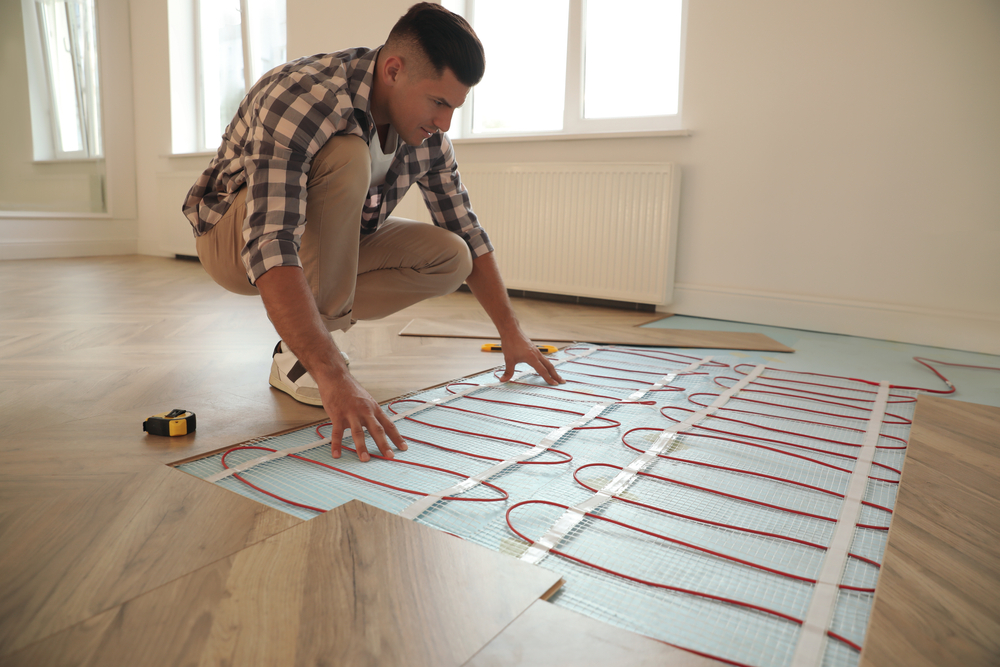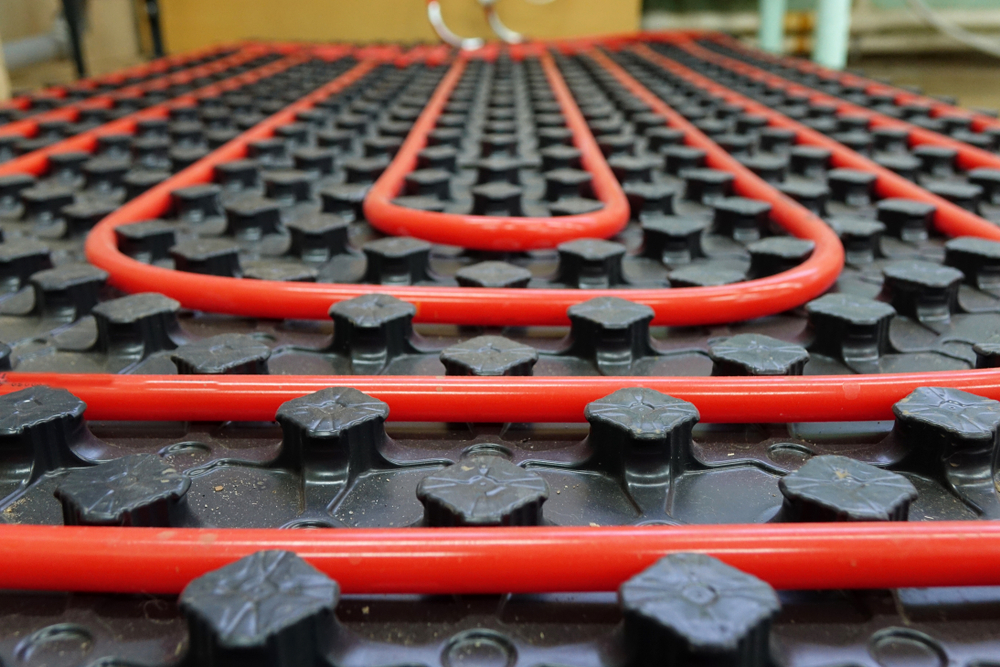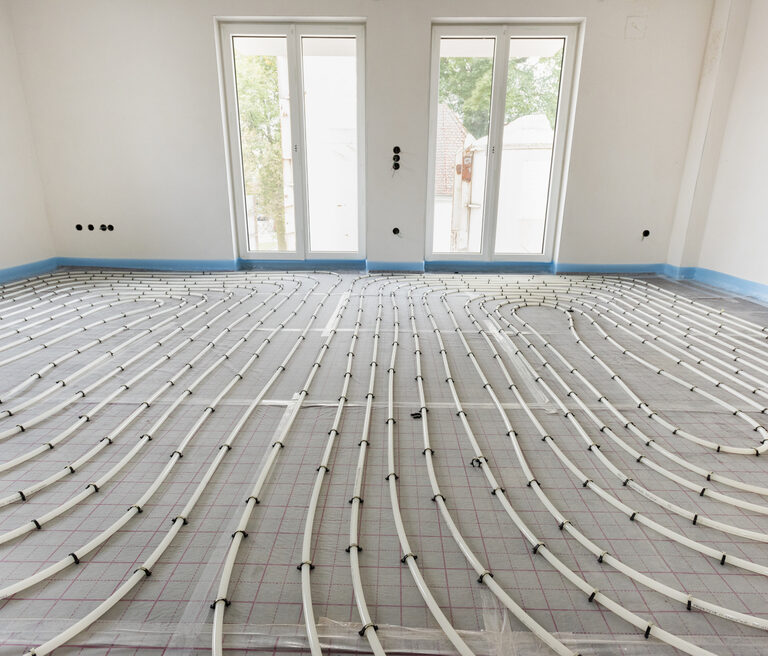Heat rises: it’s Science 101.
And that’s precisely why radiant floor heating is so effective at warming up a home. Rather than blowing hot air around in circles or emanating warmth from a radiator on the wall, radiant floor heating warms the tiles beneath your feet. In turn, the heat radiates slowly but steadily upwards, warming the house and whatever—or whoever—lies within.
It’s a luxury inclusion in any American home and a sure-fire way to remain toasty warm in winter without a sky-high utility bill. But there are a few downsides to the tech as well—primarily that it costs a pretty penny to install
In this post, we explain the nitty-gritty details of the two main radiant floor heating types. Then, we outline the pros and cons of the highly sought-after heating system so you can gauge whether it’s right for your home.
The Two Types of Radiant Floor Heating
Radiant floor heating either works through a mesh of electric resistance cables or a series of PEX tubes that pump warm water around.
Electric Radiant Floor Heating

Electric radiant floor heating is the former of the two; it is a network of heated cables or prefabricated electric mats hidden beneath the floor.
As it runs off electricity, the system isn’t especially energy-efficient and is usually used sparingly in certain rooms. The bathroom and kitchen are the most common spots to install electric floor heating, and in colder climates, the system might only supplement a separate heat source.
The cables or mats are installed in mortar over the top of the subfloor before ceramic or stone tiles are inserted on top: it’s a relatively straightforward process that an experienced DIYer could attempt. An even simpler option is using engineered hardwood finish flooring, which requires no mortar to install.
To avoid ripping out your flooring, you could opt for a radiant pad instead, which slides under the subfloor into your existing joist bays. Fiberglass batts go underneath to direct the heat away from the ground.
Hydronic Radiant Floor Heating

While the electric option is excellent for individual rooms or additional warmth, hydronic floor heating is efficient enough to cover the whole house. With this system, a furnace warms the water to around 100F and then pumps it through a network of PEX tubes under the floor.
You’ve got four options when it comes to installation. Either install the tubes over an existing concrete slab, embed them into a new one, position them into special subfloor panels, or plonk them under your subfloor. A professional installer can advise on the best course of action.
Unlike electric floor heating, you’re free to insert hardwood or carpet on top. Ceramic and stone tiles are okay, too.
The Pros and Cons of Radiant Floor Heating
Now that you’re up to speed on the two distinct types, it’s time to examine the pros and cons of having radiant floor heating in your home.
The Pros of Radiant Floor Heating
Although it can be complicated to install and even tougher to retrofit, radiant floor heating is a hit for its efficiency, comfort, and minimalist appeal.
Cheap to Run
While electric systems churn through the juice, installing them in small, specific areas like the kitchen and bathroom helps reduce operating costs. Strategic use of a thermostat and timer draws consumption down even further.
The significant energy savings, however, come with a comprehensive hydronic system, which can heat the entire home for a pittance.
Radiant heat feels more comfortable at lower temperatures than heated up air, letting you set the thermostat right down to low. For this reason, the boiler only needs to keep the water at a moderate temperature (about 100F) to warm your home.
As heat rises upwards, the floor doesn’t need to be especially hot—around 84F will do. Compare that to a traditional wall radiator, which needs to blast out heat at 149-167F to warm up a room.
Unlike other heating methods, the system isn’t susceptible to drafts. If your home isn’t entirely airtight, radiant floor heating could save you big bucks.
So, how efficient are we talking? There are too many variables to give you an exact figure for your home. However, most radiant floor systems will save you around 15% on your quarterly utility bills.
Even Distribution
The other key advantage is comfort. As the system warms up the part of the home where you live (the floor), you get smoother and more even heat distribution. In addition, all surfaces in the room heat up simultaneously, so there aren’t any lingering cold spots.
Also, radiant floor heating works non-stop, leaving your home consistently cozy throughout the day. Compare that to an air-forced furnace, which cycles on and off at a whim. As for standard radiators, they’re typically too hot when you’re sitting close by and too cold on the other side of the room.
Another nifty plus is that, unlike ducted heating, radiant floor heating won’t dry out the air, which is terrible for your skin and nasal membranes. It also won’t blow dust and allergens around as the system doesn’t need to blast air into the home.
And finally, radiant floor heating is silent. You won’t have to listen to those annoying click and whooshing sounds as air-forced furnaces cycle off and on.
Low Maintenance
Radiant floor heating systems are built to last; expect to get anywhere from 30 to 50 years out of a newly installed setup. And should the furnace break down before then, it’s easy enough to replace.
Compare that to a standard HVAC system, which could start causing issues just ten years down the track. Given that they’re so long-lasting and energy-efficient, a radiant floor heating system will add a tidy sum to the resale value of your home.
Design Freedom
Standard radiators require space on the wall, often in every room in the house. And for the design-conscious interior decorator, that’s a massive drawback to consider.
While central ducted systems can overcome this obstacle to some extent, you’ve still got to look at ugly grills and vents protruding from the walls. Floor heating, on the other hand, is totally invisible. If it weren’t so toasty warm, you wouldn’t even know it was there.
Throw in the fact that the system is utterly silent and doesn’t blow allergen-filled air around the house, and radiant floor heating is the more pleasant option overall.
The Cons of Radiant Floor Heating
While there’s lots to love about radiant floor heating, there are a few drawbacks to consider as well.
Expensive to Install
The big downside to radiant floor heating is the eye-watering installation cost. The precise amount depends on numerous factors, including the type. Nonetheless, you can expect to pay somewhere between $10 to $20 per square foot.
Therefore, if you were planning to put floor heating in the average American home (1,600 ft2), you’d be looking at somewhere between $16,000 and $32,000—that’s not an insignificant sum.
For comparison, low-end forced-air furnaces and heat pumps cost about $4,000-$5,000 (more for a high-efficiency model). In time, you’ll make back the difference through lower electricity bills with radiant floor heating.
Complex to Retrofit
Hydronic radiant floor heating is usually done in the pre-construction phase of a home. Unfortunately, it’s just too labor-intensive to install an entire network of PEX piping through an already existing subfloor.
An electric radiant heating retrofit is more viable, however, and could even be done by a skilled DIYer. In any case, you’ll need easy access to the subfloor and may have to remove large chunks of the ceiling for a two-story home.
Doesn’t Cool in Summer
While it’s theoretically possible to install a radiant cooling system in a home, it’s certainly not financially viable. You’d need a geothermal heat pump to supply cold water and then a separate network of PEX pipes running through the ceiling.
If you need to keep your home cool in the summer and warm in the winter, a traditional HVAC system is a better bet.
Is Radiant Floor Heating the Right Solution for Your Home?
Think of radiant floor heating like an investment: it’ll cost you more upfront, but you’ll save stacks of money each quarter on your electricity bill. Plus, you get the bonus of adding extra value to your home.
Whether or not it’s worth it depends on your financial situation. If you’re earning good cash and plan to reside in the same home for decades to come, you’ll eventually break even on the investment; and, you’ll get to live in warm, cozy comfort until then.
